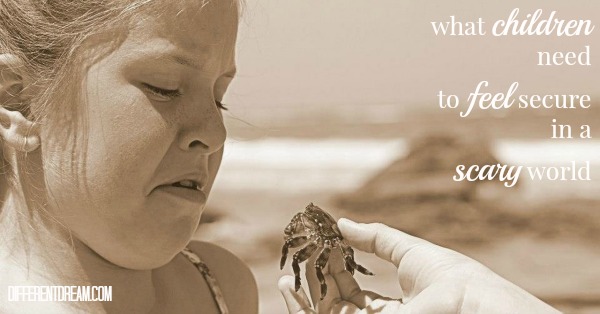Attachment Categories in Children & Inside Out Special Needs Parenting

Welcome back for another installment in Different Dream’s occasional series about special needs parenting from the inside out. So far the series has looked at basic functions of the parts of the brain, high road and low road parenting, the difference between implicit and explicit memory, and the brain’s 7 instinctual responses to perceived danger. Those posts provide basic background information about how the brain works.
Today’s post moves on from how the brain reacts to trauma and looks at how those brain responses affect behavior. One of the things I learned during the research for the book, Does My Child Have PTSD? What To Do When Your Child Is Hurting from the Inside Out, was the important role parents can play in helping their children process traumatic events. The ability of parents to assist children in trauma recovery often depends on the parents’ own experiences as children. Those experiences can affect the parents’ relationships with children and children’s relationships with their parents.
Four Attachment Categories in Children
Psychologists categorize these relationships into 4 basic categories of attachment in children. (Attachment is the word used in the world of psychology for “love” or “bonding.”) In their book, Parenting from the Inside Out: How a Deeper Self-Understanding Can Help You Raise Children Who Thrive, Dr. Daniel Siegel and Mary Hartzell describe 4 attachment categories in children, as does Alison Gopnik in her fascinating book, The Philosophical Baby. These attachment categories in children affect how they view and respond to the world.
Secure Attachment:
When parents are attuned to their children’s needs, children feel connected. This allows children to develop internal balance that leads to emotional regulation and flexibility so that they have a sense of coherence in their minds. Secure attachment enables kids to seek proximity to parent, go to parent as a safe haven, and makes their relationship with the parent a secure base and a model to follow.
Avoidant Attachment:
Not all parents are able to connect with their children enough to create a secure attachment. If the parent or primary caregiver is often unavailable and/or rejecting, either by choice or circumstance, a child may become avoidantly attached. These children avoid closeness and emotional connection with parent because they know that interacting with the parent often leads to more misery instead of comfort.
Ambivalent Attachment:
Other parents are available to their children, but communicate with them inconsistently. Sometimes they’re attentive, understanding parents. At other times, they’re aloof and dismissive. Or they might also become critical and demanding. In this situation, children become anxious and uncertain because they’re never sure if they can depend on their parents. And they don’t know what to expect from them. These children are often insecure and anxious.
Disorganized Attachment:
In the two previous categories, children have at least some positive interaction with parents. But, if a parent becomes the primary source of alarm and confusion in a child’s life because the parent’s behavior is repeatedly frightening and chaotic, a child has no safe place. The person who is supposed to be the source of security is a source of terror, someone to turn away from rather than to. In that situation, the child is stuck and develops a disorganized attachment. These children are at exceedingly high risk of being traumatized.
Your Attachment Category?
With those categories in mind, now’s the time for you to reflect upon your childhood experiences and which attachment category best describes you. The next post in this series will discuss how childhood attachment affects a person’s parenting ability.
Your Thoughts about Attachment Categories in Children?
Do you have insights or questions about any of the attachment categories in children? Feel free to share them in the comment box.
Inside Out Special Needs Parenting, Part 1
Inside Out Special Needs Parenting, Part 2
Inside Out Special Needs Parenting, Part 3
Inside Out Special Needs Parenting, Part 4
Inside Out Special Needs Parenting, Part 5
Do you like what you see at DifferentDream.com? You can receive more great content by subscribing to the quarterly Different Dream newsletter and signing up for the daily RSS feed delivered to your email inbox. You can sign up for the first in the pop up box and the second at the bottom of this page.
By Jolene
Jolene Philo is the author of the Different Dream series for parents of kids with special needs. She speaks at parenting and special needs conferences around the country. She’s also the creator and host of the Different Dream website. Sharing Love Abundantly With Special Needs Families: The 5 Love Languages® for Parents Raising Children with Disabilities, which she co-authored with Dr. Gary Chapman, was released in August of 2019 and is available at local bookstores, their bookstore website, and at Amazon.
Subscribe for Updates from Jolene
Related Posts
Wounded Children, Healing Homes Helps Adoptive and Foster Families
If you are foster or adoptive parents, Wounded Children, Healing Homes by Jayne E. Schooler; Betsy Keefer Smalley & Timothy J. Callahan is a must read.
If Hospital ERs Cause Trauma in Big Tough Guys, What about Little Kids?
A recent radio interview with Dr. John Rich caught my ear the other day. He was explaining why he wrote the book, Wrong Place, Wrong Time. After watching young black men stream through Boston City Hospital's ER with gunshot and knife wounds, he started listening to...
Brain Researchers find PTSD Marker
As I've mentioned in previous DifferentDream.com posts, (PTSD Treatment Can Change Your Child's Life, PTSD and NICU Parents: What About You?, and Critically Ill Kids and War Veterans Have What in Common?) war veterans aren't the only people who suffer from...






0 Comments